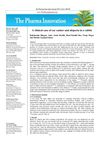
Search
for
Sort by
Research
480-510 / 667 results

research Mixed Antiandrogenic Chemicals at Low Individual Doses Produce Reproductive Tract Malformations in the Male Rat
Low doses of mixed chemicals cause permanent reproductive malformations in male rats.

research Use of Dermatoscopy and Videodermatoscopy in Therapeutic Follow-Up: A Review
Dermatoscopy and videodermatoscopy are useful and reliable for tracking treatment progress in various skin conditions.

research Improvement in Androgenetic Alopecia in 53-76-Year-Old Men Using Oral Finasteride
Finasteride increases hair count in middle-aged and elderly men without causing sexual dysfunction.

research Activation of the Human Transient Receptor Potential Vanilloid Subtype 1 by Essential Oils
Certain essential oils can activate a human skin receptor, potentially helping with skin disorders.

research Contact Alopecia: Improvement of Alopecia with Discontinuation of Fluocinolone Oil in Individuals Allergic to Balsam Fragrance
Stopping the use of fluocinolone oil containing balsam fragrance improved hair regrowth in children allergic to it.

research Rational Design of a Topical Androgen Receptor Antagonist for the Suppression of Sebum Production with Properties Suitable for Follicular Delivery
A new compound was created in 2010 that can control oil production when applied to the skin, and its effects are completely reversible after two weeks.

research Ammonium Bisulfite Contact Dermatitis: Face Eczema Due to a Bleaching Ointment Used During Hair-Dyeing
Ammonium bisulfite in hair bleach can cause facial eczema.

research A New Aliphatic Ester of Hydroxysalicylic Acid from Fermented Carica Papaya L. Preparation with Potential Hair Growth Stimulating Activity
A new compound from fermented papaya may help stimulate hair growth.

research A Clinical Case of Ear Canker and Alopecia in a Rabbit
The rabbit's ear canker and hair loss improved significantly with treatment.

research Poikiloderma, Hyperpigmentation, Alopecia, Hypohidrosis, Malformed Bones, Lymphedema of the Legs and Decreased Cortisol Level: A New Entity?
A new medical syndrome may include skin changes, hair loss, sweating issues, bone malformations, leg swelling, and low cortisol.

research Dermatological Drugs, Topical Agents, and Cosmetics
Natural products like propolis are causing more skin allergies, and certain skin treatments and medications have various side effects and risks.

research Pharmacology of Anabolic Steroids
Anabolic steroids can build muscle and strength but have risks and need more research on their clinical benefits and side effects.

research Surface Modification and Endothelialization of Biomaterials as Potential Scaffolds for Vascular Tissue Engineering Applications
Improving artificial vascular grafts requires better materials and surface designs to reduce blood clotting and support blood vessel cell growth.

research Environmental Factors and Puberty Timing: Expert Panel Research Needs
Chemicals and body size might change when puberty starts and progresses, but more research is needed to confirm this.

research Deletion of DNA Binding Domain of the Vitamin D Receptor Abrogates Genomic and Nongenomic Functions of Vitamin D
Removing part of the vitamin D receptor stops vitamin D from working properly.

research Timing of Expression of the Core Clock Gene Bmal1 Influences Its Effects on Aging and Survival
The timing of when the gene Bmal1 is active affects aging and survival, with its absence during development, not adulthood, leading to premature aging.

research The Diagnosis and Treatment of Iron Deficiency and Its Potential Relationship to Hair Loss
Iron deficiency may be related to hair loss, but there's not enough evidence to recommend iron screening or supplements for all hair loss patients.

research Tissue Engineering of Human Hair Follicles Using a Biomimetic Developmental Approach
Researchers created human hair follicles using a new method that could help treat hair loss.

research Essential Oils and Their Single Compounds in Cosmetics: A Critical Review
Essential oils in cosmetics can offer benefits but may cause allergies and should be used carefully.

research Demodicosis and Rosacea: Epidemiology and Significance in Daily Dermatologic Practice
Demodicosis is common and often missed, needing more recognition and treatment in skin care.

research Design, Synthesis, and Preclinical Evaluation of Prostate-Specific Membrane Antigen Targeted 99mTc-Radioimaging Agents
Researchers developed promising agents for prostate cancer imaging, with the best one showing high potential for clinical use.

research Cepharanthine: An Update of Its Mode of Action, Pharmacological Properties, and Medical Applications
Cepharanthine is a well-tolerated drug with multiple medical uses, including anti-inflammatory and anti-cancer properties.

research Alopecia Areata: Pathogenesis And Treatment
No single treatment is consistently effective for alopecia areata, and more research is needed.

research Tissue Engineering and Regenerative Medicine: Achievements, Future, and Sustainability in Asia
Asia has made significant progress in tissue engineering and regenerative medicine, but wider clinical use requires more development.

research 2-Substituted 4-(Thio)chromenone 6-O-Sulfamates: Potent Inhibitors of Human Steroid Sulfatase
New compounds were made that block an enzyme linked to breast cancer better than existing treatments.

research Androgenetic Alopecia: An Update
Minoxidil and finasteride effectively treat hair loss.

research Hair Growth and Rejuvenation: An Overview
The document concludes that minoxidil and finasteride are proven for hair growth, herbal remedies show promise, but more research is needed to confirm their effectiveness.

research Safety of Dermatologic Medications in Pregnancy and Lactation
Most dermatologic medications are safe during pregnancy and breastfeeding, but some should be avoided due to potential risks.

research Potential Targets in the Discovery of New Hair Growth Promoters for Androgenic Alopecia
The document concludes that targeting 5α-reductase, the androgen receptor, and hair growth genes, along with using compounds with anti-androgenic properties, could lead to more effective hair loss treatments.